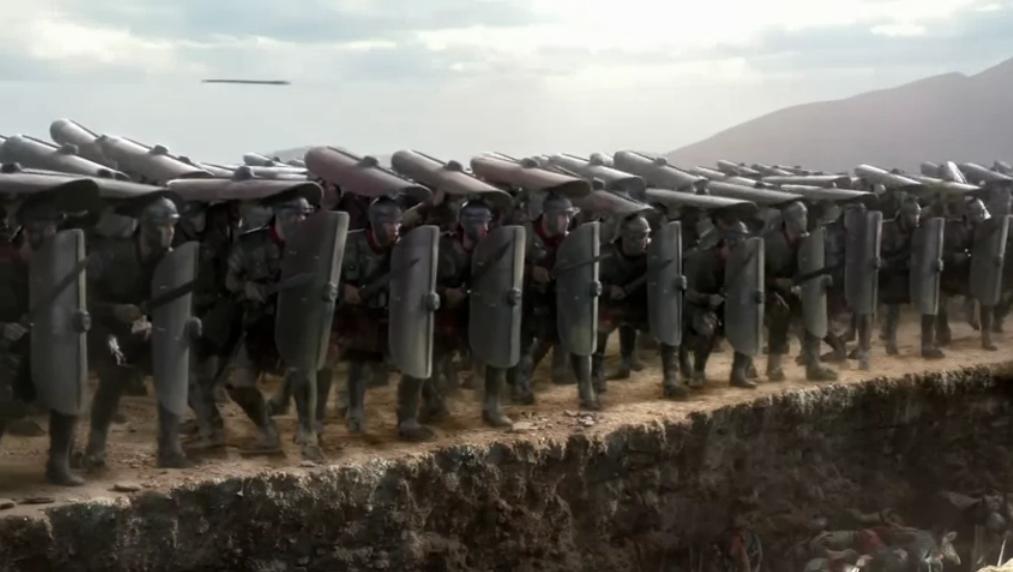3.THE ROMAN LEGION
The single most successful,long lasting and influential infantry formation in history the legions were rome's instrument of destruction,through which it conquered and ruled the ancient world for nearly 700 years!Even after the western roman empire fell,the eastern roman empire would last another 1000 yrs and their infantry too was based on the original roman model,though weapons and tactics had changed.Later european armies like the spanish tercio,again and again tried to capture the key principles of the roman success.

Uploaded with
ImageShack.us
This will be discussed in 3-4 parts because of the massive time frame,rome's legions constantly evolved and so did the tactics.Also because of the extensive information available on them.
Part 1;The republican legions
The legion['levy' in latin] began its career in a unspectacular manner .The first legions were essentially hoplites who fought in the greek manner with a round shield and spear and a straight sword in rigid formations.In the hilly terrain of italy they lost heavily to their more mobile samnite foes,and in 390 bc the gauls even sacked rome itself.This first incarnation of the legion was known as the servian legion.


Uploaded with
ImageShack.us
The Upper and lower tier of roman servian legionaries,equipment according to class divisions and wealth.Fought mostly as hoplites,with some skirmishers,archers and light cavalry in support.
Uploaded with
ImageShack.us
The romans learned,adapted and put forward a new system known as the manipular legion adopted from their enemies,the italian samnites but perfected by rome.
The new army was deployed in three liens known as maniples in a triplex aces.The first line were the 1200 hastati[young men of around 20.green with little combat experience].The second line were 1200 princeps [men at the prime of their life,combat experienced,usually former hastati] and third line of 600 triarii,older veterans.

Uploaded with
ImageShack.us
Hastati.They shed the spear.Adopted the new heavy throwing javelin the pilum and the stabbing short sword ,the greek hoplite shield was discarded in favour of the samnite oval scutum shield.The hastati would discharge their javelins before charging.

Uploaded with
ImageShack.us
2nd line princeps,similar equipment with heavier armour.

Uploaded with
ImageShack.us
The final line,they retained the hasta spear and fought as hoplites.
These 3 were supported by a screen of skirmishers called velites.
The main genius of the formation was in its organization..Within this triplex acies system, contemporary Roman writers talk of the maniples adopting a checkered formation called quincunx when deployed for battle but not yet engaged. In the first line, the hastati left gaps equal in size to their cross-sectional area between each maniple. The second line consisting of principes followed in a similar manner, lining up behind the gaps left by the first line. This was also done by the third line, standing behind the gaps in the second line. The velites were deployed in front of this line in a continuous, loose-formation line.

Uploaded with
ImageShack.us
As the army approached its enemy, the velites in front would throw their javelins at the enemy and then retreat through the gaps in the lines. This was an important innovation since in other armies of the period skirmishers would have to either retreat through their own armies ranks, causing confusion, or else flee around either flank of their own army. After the velites had retreated through the hastati, the 'posterior' century would march to the left and then forward so that they presented a solid line, creating a solid line of soldiers. The same procedure would be employed as they passed through the second and third ranks or turned to the side to channel down the gap between the first and second rows on route to help guard the legion's flanks

Uploaded with
ImageShack.us
At this point, the legion then presented a solid line to the enemy and the legion was in the correct formation for engagement. When the enemy closed, the hastati would charge. If they were losing the fight, the 'posterior' century returned to its position creating gaps again. Then the maniples would fall back through the gaps in the principes, who followed the same procedure to form a battle line and charge. If the principes could not break the enemy, they would retreat behind the triarii and the whole army would leave the battlefield in good order. According to some writers, the triarii formed a continuous line when they deployed, and their forward movement allowed scattered or discomfited units to rest and reform, to later rejoin the struggle.
The manipular system allowed engaging every kind of enemy even in rough terrain, because the legion had both flexibility and toughness according to the deployment of its lines. Lack of a strong cavalry corps however, was a major flaw of the Roman forces.
Still don't get it?Go see the flash animation on this link.
A Warhammer Ancient Battles Site
The checkerboard formation in action,.When engaged they would present a solid line.[can't post more than 8 images per post,so will make a isolated post to display the checkerboard formation within each maniple after this post].
Another unique feature of the Roman infantry was the depth of its spacing. Most ancient armies deployed in shallower formations, particularly phalanx-type forces. Phalanxes might deepen their ranks heavily to add both stamina and shock power, but their general approach still favored one massive line, as opposed to the deep three-layer Roman arrangement. The advantage of the Roman system is that it allowed the continual funneling or metering of combat power forward over a longer periodmassive, steadily renewed pressure to the frontuntil the enemy broke.If both the hastati and princeps failed they could either retreat behind the triarii to reform while they presented a barrier of pikes and retire in good order or attack again with the triarii acting as the final reserve.
This was primarily the army that conquered greece,carthage and the seleucids and won rome the dominance of the mediteranean.
PART 2;Marian legions.Caesar.
















